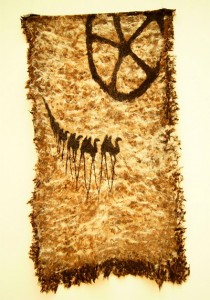 ASTANA – Astana’s Shezhire Gallery and the Women of the Steppe Public Foundation brought together Kazakhs and foreigners in Astana at the Ramada Plaza Hotel on Feb. 10 for a lesson in making felt products.
ASTANA – Astana’s Shezhire Gallery and the Women of the Steppe Public Foundation brought together Kazakhs and foreigners in Astana at the Ramada Plaza Hotel on Feb. 10 for a lesson in making felt products.
Zamzegul Oralbayeva, who led the class, is president of the Women of the Steppe and a member of Kazakhstan’s artists’ union. With the Shezhire Gallery, she set out to attract public attention to the recovery of the dying folk art of feltwork and traditional Kazakh methods of felting. Kazakh ornamentation and its meaning were also main topics of the class.
Kazakh traditional culture was present in every detail of the setting. Baursaks (traditional fried dough balls) were served with tea, an integral part of the national culture. Felt and feltworking tools were the centrepiece of the hall.
“There are not many people in Kazakhstan who know the ancient technique of making felt clothes, decorations, blankets and other things. Zamzegul is one of those people who treasures the culture of our people and is ready to share her knowledge with you at our master class,” Roza Zhussupova, director of the Shezhire Gallery, said when opening the class.
To start the class, Oralbayeva showed participants the difference in structure between spring and autumn felt. Spring felt is light and can be coloured, while autumn felt is stiff and sticky and cannot be coloured because of its structure. Each must be worked a different way.
“The unique art of the Kazakh people was formed under the conditions of nomadic life and in many aspects was defined by the nature of nomadic production. The emergence of its main items was conditioned by the need to decorate yurts and their furniture. Thus, the production of carpets, wall decorations, wrought felt bags, chair covers and clothes was developed,” Oralbayeva said.
“The folk imagination attached magic meanings to ornaments and considered certain patterns necessary for the successful development of a household,” Oralbayeva said.
The most famous motif in Kazakh felt carpets is the qoshqar muiyz, Kazakh for sheep’s horn, which symbolises wealth and prosperity. The horn motif has become a felt-work calling card.
Kazakh felt carpets are pressed, not woven. After laying the base and arranging the decorations, the whole piece is sprinkled with soapy water and pressed, then squeezed and dried. Participants in the class executed these processes and left with a handmade piece of felt art.
The master class was held as part of the Shezhire Gallery’s programme for supporting and reviving Kazakh national traditions. The next event will be the opening of artist, architect and designer Bakhtybek Talkambayev’s exhibit dedicated to Kazakh spirituality, Mangilik Yel, on Feb. 19.

